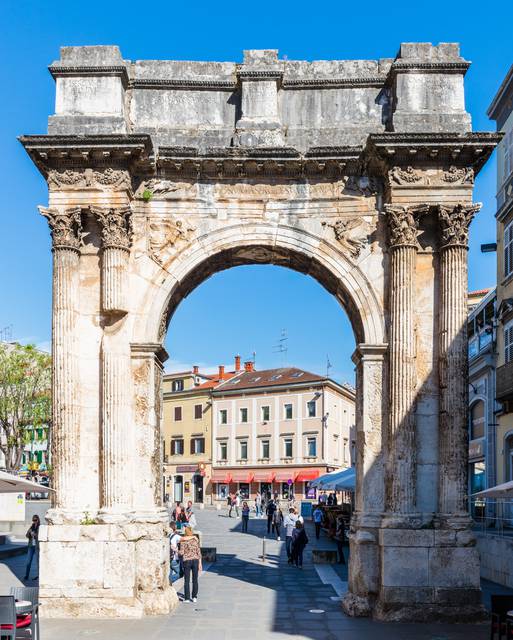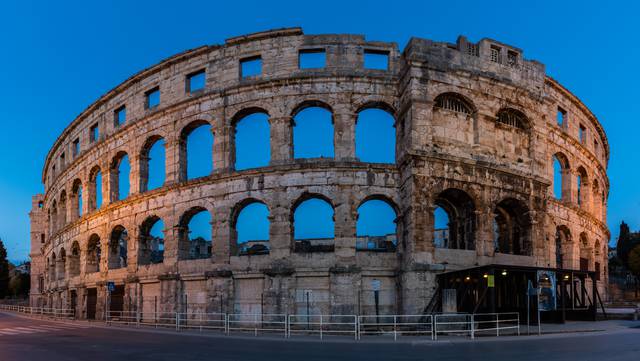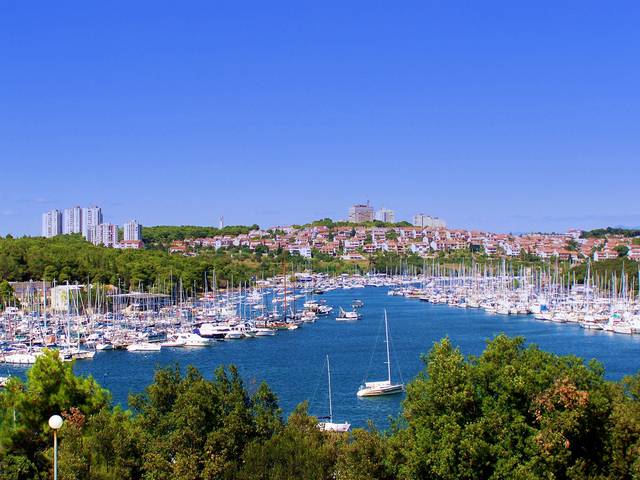
Pula (Italian: Pola, Slovene: Pulj) is a nice town at the tip of the Istrian peninsula in northwestern Croatia.
Its history started about 3000 years ago when it was built by Illyrians. Romans occupied Istria in 177 BC. After the destruction of the Western Roman Empire, the Istrian peninsula was devastated by Ostrogoths. Slavs came in Istria during migration period in 7th century but mostly lived on countryside. At that time Pula was still inhabited mostly by Italians. Landlords in Pula changed quite frequently in the Middle Ages from the Republic of Venice to Genoa to Illyrian Provinces and Austria–Hungary. After the Second World War, it became part of Croatia. At that time, many Italians fled to Italy and Pula was settled by Croats. Although most of the population is Croatian, there are several large minority groups in Pula such as Serbs, Italians, Bosniaks and Slovenes.
Most tourists visit in the summer months, with most attractions and restaurants closing between October and May.
The climate of Pula is warm to hot during the summer months, and cool to cold during winter. Average temperatures during July, the hottest month range from 18° to 29°, while in January, the coldest month, temperatures range from an average low of 1° to 10° Spring and autumn are generally mild in comparison

- Arena. The 6th largest surviving Roman amphitheatre. Towering over the nearby buildings this huge structure was barely saved from destruction several times during its life, mostly by various Venetians with plans to take it to Venice stone by stone as demonstration of the might of the Venetian empire. Many stones were taken to build houses and other structures around Pula, but fortunately this practice was stopped before the whole structure was destroyed. Entry gives you access to wander the inside of the Colosseum and visit the caverns beneath. The audio tour is very worthwhile. 50 kn regular, 25 kn for pupils and students.
- The Forum. The "Forum" is the main square in the centre of the city. The square is built on the site of the ancient Roman forum. On the square there is a city hall that was built in the 10th century (parts of an old temple were used for the building as it can be seen on the rear side of the hall) and the Temple of August, from the first century.
- Archeological Museum of Istria.
- Zlatna vrata (Triumphal arch, 1st century BC), Dvojna vrata (Twin gate, 2-3rd century), Herkulova vrata (Hercules gate, 1st century BC).
- St. Francis church and monastery, 14th century
- Orthodox church, 6th century
- Kaštel, a Castle from the 17th century features Istrian history museum
- Malo rimsko kazalište, Little Roman theatre behind the Archeology museum
- Mornaričko groblje, Sailors' cemetery (1866 - about 150,000 soldiers of Austro-Hungarian nations were buried there) and Mornarička crkva, Sailors' Church
Arena. The 6th largest surviving Roman amphitheatre. Towering over the nearby buildings this huge structure was barely saved from destruction several times during its life, mostly by various Venetians with plans to take it to Venice stone by stone as demonstration of the might of the Venetian empire. Many stones were taken to build houses and other structures around Pula, but fortunately this practice was stopped before the whole structure was destroyed. Entry gives you access to wander the inside of the Colosseum and visit the caverns beneath. The audio tour is very worthwhile. 50 kn regular, 25 kn for pupils and students.
The Forum. The "Forum" is the main square in the centre of the city. The square is built on the site of the ancient Roman forum. On the square there is a city hall that was built in the 10th century (parts of an old temple were used for the building as it can be seen on the rear side of the hall) and the Temple of August, from the first century.
Archeological Museum of Istria.
Zlatna vrata (Triumphal arch, 1st century BC), Dvojna vrata (Twin gate, 2-3rd century), Herkulova vrata (Hercules gate, 1st century BC).
St. Francis church and monastery, 14th century
Orthodox church, 6th century
Kaštel, a Castle from the 17th century features Istrian history museum
Malo rimsko kazalište, Little Roman theatre behind the Archeology museum
Mornaričko groblje, Sailors' cemetery (1866 - about 150,000 soldiers of Austro-Hungarian nations were buried there) and Mornarička crkva, Sailors' Church

- Visit Brijuni. Group of islands famous for their scenic beauty. They are a holiday resort and a Croatian National Park. They were also settled in Roman times and were part of Republic of Venice. There is also the famous residence of Josip Broz Tito (leader of former Yugoslavia). Boats go from small town near Pula named Fažana.
- Go on Fish picnic. You can take a walk through local marina and check out timetables and prices. Prices are usually around 250 kn per person.
- Walk down the Sergijevaca street where are many small shops, souvenir shops, bars and even sweet shops.
- Spend a whole day on beaches of Kamenjak, near Premantura (8 km from Pula). This peninsula is southernmost point of Istria, and features stunning landscapes and protected nature.
- Discover abandoned Austro-Hungarian fortresses, constructed just before World War I, when Pula was most fortified city in Europe. Some of those fortresses are hidden in the forests, and some are now occupied by Pula residents for different purposes, including Punta Christo, which operates as a summer club and music festival venue.
- Visit Pula Film Festival takes place yearly in the Arena in the second half of July.
Visit Pula Film Festival takes place yearly in the Arena in the second half of July.
Visit Brijuni. Group of islands famous for their scenic beauty. They are a holiday resort and a Croatian National Park. They were also settled in Roman times and were part of Republic of Venice. There is also the famous residence of Josip Broz Tito (leader of former Yugoslavia). Boats go from small town near Pula named Fažana.
Go on Fish picnic. You can take a walk through local marina and check out timetables and prices. Prices are usually around 250 kn per person.
Walk down the Sergijevaca street where are many small shops, souvenir shops, bars and even sweet shops.
Spend a whole day on beaches of Kamenjak, near Premantura (8 km from Pula). This peninsula is southernmost point of Istria, and features stunning landscapes and protected nature.
Discover abandoned Austro-Hungarian fortresses, constructed just before World War I, when Pula was most fortified city in Europe. Some of those fortresses are hidden in the forests, and some are now occupied by Pula residents for different purposes, including Punta Christo, which operates as a summer club and music festival venue.
- Truffles — Istria is famous for its truffles and various truffle products.
- Malvazija and Teran — Istrian wine varieties.
- Medica — a honey rakija.
- Biska — a rakija with mistletoe.
Truffles — Istria is famous for its truffles and various truffle products.
Malvazija and Teran — Istrian wine varieties.
Medica — a honey rakija.
Biska — a rakija with mistletoe.
- Restaurant Farabuto. Excellent light and delicious slow food.
- Restaurant Galeb, Osječka 37, Monterizzi, Stoja. You won't find this one in any tourist guide, but everyone in the city knows the place: they serve best "chevapchichi" (minced meat, 5 cm x 1½ cm) in the city.
- Restaurant Gina. Excellent food in a unique setting that combines elegance with history.
- Restaurant Asterix. The best pizza in town. You should try the Asterix pizza, which means you can have a pizza divided into thirds, with a different set of toppings (kinds of pizza) on each one.
- Pizzeria Jupiter. Near Arena, the Roman amphitheatre - very good pizza.
- Restaurant El Pulari. A Mexican restaurant.
- Restaurant Biska.
Restaurant Farabuto. Excellent light and delicious slow food.
Restaurant Galeb, Osječka 37, Monterizzi, Stoja. You won't find this one in any tourist guide, but everyone in the city knows the place: they serve best "chevapchichi" (minced meat, 5 cm x 1½ cm) in the city.
Restaurant Gina. Excellent food in a unique setting that combines elegance with history.
Restaurant Asterix. The best pizza in town. You should try the Asterix pizza, which means you can have a pizza divided into thirds, with a different set of toppings (kinds of pizza) on each one.
Pizzeria Jupiter. Near Arena, the Roman amphitheatre - very good pizza.
Restaurant El Pulari. A Mexican restaurant.
Restaurant Biska.
Drinking is a pleasurable pastime in Croatia. Since Pula is a very popular place for tourists bars are easy to find.
- National Park Brijuni - The beautiful Brijuni islands (also referred to as Brioni) stretch alongside the south-west coast of the Istrian peninsula. The national park offers too many attractions for all of them to be described here (dinosaur footprints, archaeological finds and sites, a little zoo, extremely rich flora and fauna, beautiful beaches, a former resort for European royals) so visit their website for more information.
- Rovinj, Rovigno
- Poreč, Parenzo
- Grožnjan, Grisignana
- Motovun, Montona
National Park [[Brijuni]] - The beautiful Brijuni islands (also referred to as Brioni) stretch alongside the south-west coast of the Istrian peninsula. The national park offers too many attractions for all of them to be described here (dinosaur footprints, archaeological finds and sites, a little zoo, extremely rich flora and fauna, beautiful beaches, a former resort for European royals) so visit their website for more information.
[[Rovinj]], Rovigno
[[Poreč]], Parenzo
[[Grožnjan]], Grisignana
[[Motovun]], Montona
